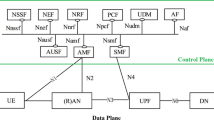Abstract
In the past few decades, the world has witnessed a rapid growth in mobile communication and reaped great benefits from it. Even though the fourth generation (4G) mobile communication system is just being deployed worldwide, proliferating mobile demands call for newer wireless communication technologies with even better performance. Consequently, the fifth generation (5G) system is already emerging in the research field. However, simply evolving the current mobile networks can hardly meet such great expectations, because over the years the infrastructures have generally become ossified, closed, and vertically constructed. Aiming to establish a new paradigm for 5G mobile networks, in this article, we propose a cross-layer software-defined 5G network architecture. By jointly considering both the network layer and the physical layer together, we establish the two software-defined programmable components, the control plane and the cloud computing pool, which enable an effective control of the mobile network from the global perspective and benefit technological innovations. Specifically, by the cross-layer design for software-defining, the logically centralized and programmable control plane abstracts the control functions from the network layer down to the physical layer, through which we achieve the fine-grained controlling of mobile network, while the cloud computing pool provides powerful computing capability to implement the baseband data processing of multiple heterogeneous networks. The flexible programmability feature of our architecture makes it convenient to deploy cross-layer technological innovations and benefits the network evolution. We discuss the main challenges of our architecture, including the fine-grained control strategies, network virtualization, and programmability. The architecture significantly benefits the convergence towards heterogeneous networks and enables much more controllable, programmable and evolvable mobile networks. Simulations validate these performance advantages.





Similar content being viewed by others
References
Zaki Y, Zhao L, Goerg C, Timm-Giel A (2011) Lte mobile network virtualization. Mob Netw Appl 16 (4):424–432
Karjaluoto H (2007) An investigation of third generation (3g) mobile technologies and services. Contemp Manag Res 2 (2):91–104
Kennedy M, Ksentini A, Hadjadj-Aoul Y, Muntean G (2013) Adaptive energy optimization in multimedia-centric wireless devices: a survey. IEEE Commun Surv Tutor 15 (2):768–786
Ericsson (2012) Mobile report on the pulse of the networked society. Ericsson Mobility Report. http://www.ericsson.com/res/docs/2012/ericsson-mobility-report-november-2012.pdf. Accessed November 2012
Chen BX (2012) Carriers warn of crisis in mobile spectrum. The New York Times. http://www.nytimes.com/2012/04/18/technology/mobile-carriers-warn-of-spectrum-crisis-others-see-hyperbole.html?pagewanted=all. Accessed 17 April 2012
Chen M, Mao S, Liu Y (2014) Big data: a survey. Mob Netw Appl 19(2):171–209
Chen M, Mao S, Zhang Y, Leung V (2014) Big data: related technologies, challenges and future prospects. Springer Briefs in Computer Science
Wang X, Chen M, Taleb T, Ksentini A, Leung V. (2014) Cache in the air: enabling the green multimedia caching and delivery for the 5G network. IEEE Commun Mag 52(2):131–139
Yu M, Rexford J, Freedman MJ, Wang J (2010) Scalable flow-based networking with difane. SIGCOMM Comput Commun Rev 41(4):351–362
Kim H, Feamster N (2013) Improving network management with software defined networking. IEEE Commun Mag 51 (2):114– 119
Bansal M, Mehlman J, Katti S, Levis P (2012) Openradio: a programmable wireless dataplane. In: Proceedings of the first workshop on Hot topics in software defined networks, ser. HotSDN ’12, New York, pp 109–114
McKeown N, Anderson T, Balakrishnan H, Parulkar G, Peterson L, Rexford J, Shenker S, Turner J (2008) Openflow: enabling innovation in campus networks. SIGCOMM Comput Commun Rev 38(2):69–74
Li L, Mao Z, Rexford J (2012) Toward software-defined cellular networks. In: 2012 European Workshop on Software Defined Networking (EWSDN). Berlin, pp 7–12
Gudipati A, Perry D, Li LE, Katti S (2013) Softran: software defined radio access network. In: Proceedings of the second ACM SIGCOMM workshop on Hot topics in software defined networking, ser. HotSDN ’13, New York, pp 25–30
Kumar S, Cifuentes D, Gollakota S, Katabi D (2013) Bringing cross-layer mimo to today’s wireless lans. SIGCOMM Comput Commun Rev 43(4):387–398
Jin X, Li LE, Vanbever L, Rexford J (2013) Softcell: Scalable and flexible cellular core network architecture. In: Proceedings of the Ninth ACM Conference on Emerging Networking Experiments and Technologies, ser. CoNEXT ’13, New York, pp 163– 174
Pentikousis K, Wang Y, Hu W (2013) Mobileflow: Toward software-defined mobile networks. IEEE Commun Mag 51(7):44–53
Yap KK, Sherwood R, Kobayashi M, Huang TY, Chan M, Handigol N, McKeown N, Parulkar G (2010) Blueprint for introducing innovation into wireless mobile networks. In: Proceedings of the Second ACM SIGCOMM Workshop on Virtualized Infrastructure Systems and Architectures, ser. VISA ’10, New York, pp 25–32
Chowdhury NMK, Boutaba R (2010) A survey of network virtualization. Comput Netw 54(5):862–876
Ofcom (2012) Sitefinder: Mobile Phone Base Station Database. http://www.sitefinder.ofcom.org.uk/. Accessed 17 December 2013
Acknowledgments
This work is supported by National Basic Research Program of China (973 Program Grant No. 2013CB329105), National Natural Science Foundation of China (Grants No. 61301080, No. 61171065, 61271279, and 61201157), Chinese National Major Scientific and Technological Specialized Project (No. 2013ZX0300 2001 and 2014AA01A707), Chinas Next Generation Internet (No. CNGI-12-03-007), and the Fundamental Research Foundation of NPU (Grant No. JCY20130131).
Author information
Authors and Affiliations
Corresponding author
Rights and permissions
About this article
Cite this article
Yang, M., Li, Y., Hu, L. et al. Cross-Layer Software-Defined 5G Network. Mobile Netw Appl 20, 400–409 (2015). https://doi.org/10.1007/s11036-014-0554-3
Published:
Issue Date:
DOI: https://doi.org/10.1007/s11036-014-0554-3




